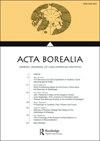Two Centuries of Russian Sámi Policy: Arrangements for Autonomy and Participation Seen in Light of Imperial, Soviet and Federal Indigenous Minority Policy 1822–2014
IF 0.6
4区 社会学
0 HUMANITIES, MULTIDISCIPLINARY
引用次数: 7
Abstract
Abstract This article reviews arrangements for Russian Sámi self-government during the Late Imperial (1822–1917), Soviet (1917–1991) and Federal (1992–) Eras of Russian history, comparing them to developments in the country's general indigenous minority policy. Since the Soviet Era, indigenous minority policy has been delimited to a subset of the country's actual indigenous nations – smaller groups traditionally involved in certain rural economic activities. State paternalism, the framing of indigenous minority policy as giving aid to weak groups, is a constant trait of Russian indigenous minority policy. This paternalism has been channelled towards different goals at different times – the building of Communist nations, assimilation, or traditionalist preservationism. Indigenous minority policy has generally been weakly institutionalized, and its interests come into conflict with stronger actors who anchor their political activity in northern economic development and state security. Different forms of territorial autonomy have been practiced throughout the period, non-territorial arrangements becoming more common only in the Federal Era. Russian Sámi politics generally match the national trends but are a case of particularly weak indigenous autonomy and participation. A very case-specific phenomenon is the Federal Era conflict over whether or not to import the Nordic Sámi Parliament model. Case-specifics are explained by the weak demographic position of the Russian Sámi, the lack of any significant symbolic connection between the province and its indigenous people, and the border-proximity and border-transcendence of the Sámi people, which has repeatedly been used to frame their activism as a security concern.两个世纪的俄罗斯Sámi政策:从帝国、苏联和联邦土著少数民族政策1822-2014看自治与参与的安排
摘要:本文回顾了俄罗斯帝国晚期(1822-1917)、苏维埃时期(1917-1991)和联邦时期(1992 - 1992)俄罗斯Sámi自治的安排,并将其与该国总体土著少数民族政策的发展进行了比较。自苏联时代以来,土著少数民族政策一直局限于该国实际土著民族的一个子集- -传统上参与某些农村经济活动的较小群体。国家家长式作风,将土著少数民族政策框定为对弱势群体的援助,是俄罗斯土著少数民族政策的一贯特征。这种家长式作风在不同时期有不同的目的——建立共产主义国家、同化或传统的保护主义。总体而言,土著少数民族政策的制度化程度较弱,其利益与将其政治活动锚定在北部经济发展和国家安全上的更强大的行动者发生冲突。在整个时期实行了不同形式的领土自治,非领土安排只是在联邦时期才变得更为普遍。俄罗斯Sámi政治总体上符合国家趋势,但是一个特别弱的土著自治和参与的例子。一个非常具体的现象是联邦时代关于是否引进北欧Sámi议会模式的冲突。具体情况可以用以下因素来解释:俄罗斯人Sámi在人口统计学上的弱势地位,该省与其土著人民之间缺乏任何重要的象征性联系,以及Sámi人的边界邻近和边界超越,这一再被用来将他们的行动主义框定为安全问题。
本文章由计算机程序翻译,如有差异,请以英文原文为准。
求助全文
约1分钟内获得全文
求助全文

 求助内容:
求助内容: 应助结果提醒方式:
应助结果提醒方式:


